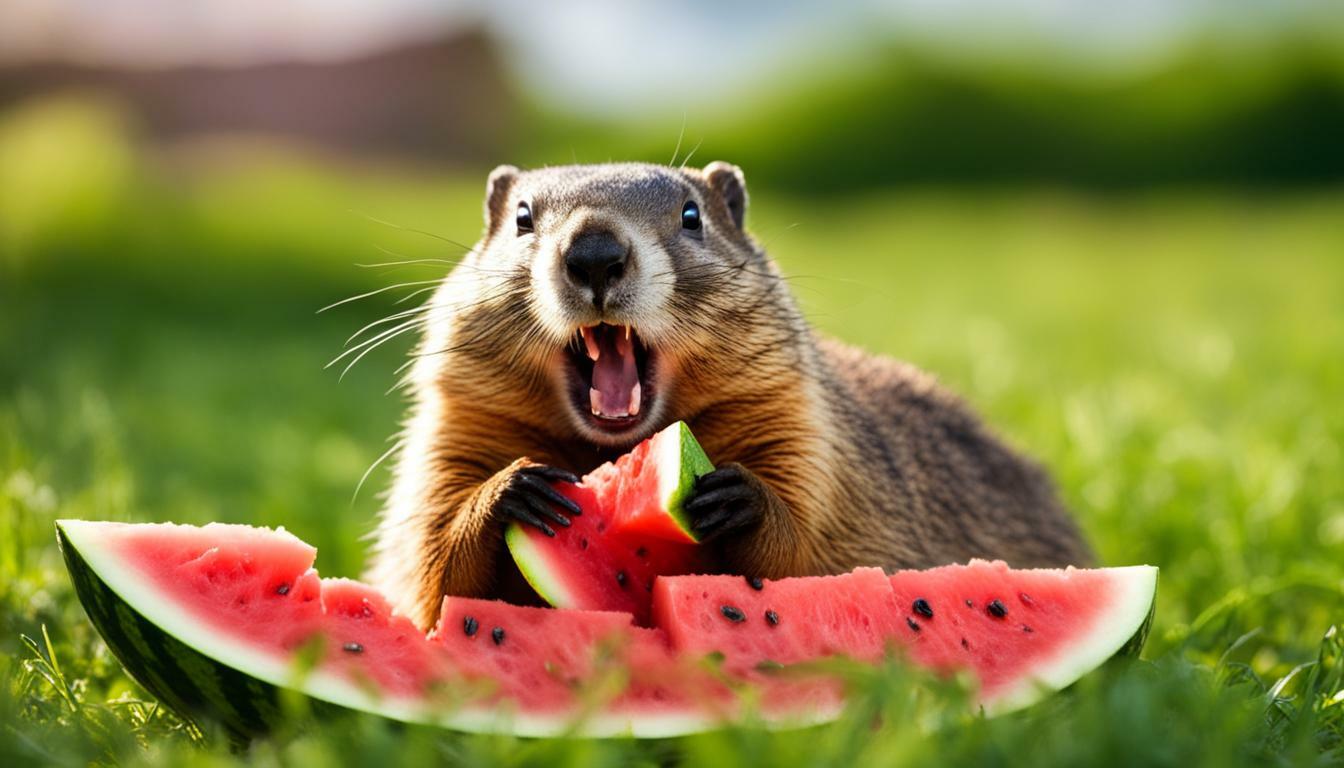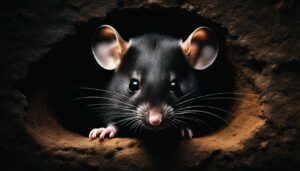Groundhogs are herbivores with a varied diet, but do they include watermelon in their meals? This question may have crossed the minds of curious gardeners and nature enthusiasts alike. Let’s explore the eating habits of groundhogs and find out if watermelon is a part of their culinary repertoire.
- Groundhogs are herbivores and primarily consume plant material.
- Watermelon is one of the fruits that groundhogs enjoy, along with other vegetables and fruits.
- They tend to eat the juicy, red part of the watermelon, leaving the rind and seeds behind.
- While not a favorite food, groundhogs do consume watermelon in small quantities.
- Backyard owners should take measures to protect their watermelon and other plants from groundhog interference, such as using fencing and natural repellents.
Now that we’ve established the herbivorous nature of groundhogs and their occasional indulgence in watermelon, let’s dive deeper into their eating habits and explore how they consume this juicy fruit.
Understanding Groundhog Diets
Before we determine if groundhogs eat watermelon, let’s explore their overall diet and food preferences. Groundhogs, also known as woodchucks, are herbivores and primarily consume plant material. Their diets consist of a variety of vegetables, fruits, grasses, and legumes.
Groundhogs have a preference for leafy greens such as lettuce, spinach, and kale. They also enjoy snacking on other vegetables like carrots, peas, and beans. Fruits like apples, berries, and melons are also part of their diet, including watermelon.
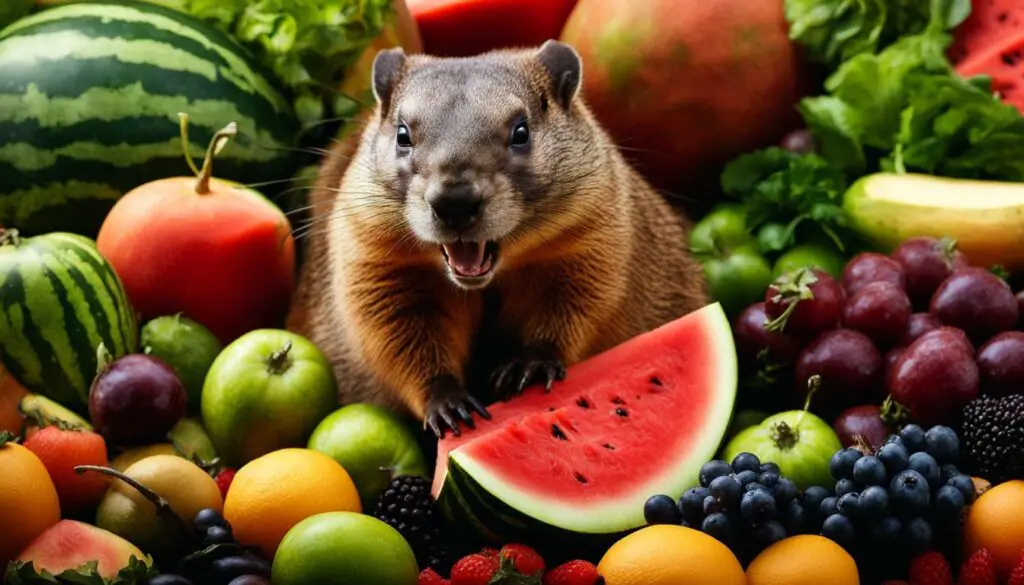
When it comes to watermelon, groundhogs are known to eat the juicy, red part of the fruit, leaving behind the rind and seeds. While watermelon may not be their favorite food, groundhogs do consume it in small quantities. It’s important to note that watermelon should be offered as a treat and not as a staple in their diet.
To discourage groundhogs from damaging your watermelon plants and other vegetation, it is advisable to take preventive measures. Fencing your garden can be an effective way to keep groundhogs out. Additionally, using natural repellents like garlic or predator urine can help deter these herbivores from feasting on your plants.
Groundhog Diet Overview:
| Vegetables | Fruits | Grasses | Legumes |
|---|---|---|---|
| Lettuce | Apples | Grass | Beans |
| Spinach | Berries | Clover | Peas |
| Kale | Melons | Dandelions | |
| Carrots |
Groundhogs have a varied diet, consuming a range of vegetables, fruits, grasses, and legumes. While watermelon is not a staple in their diet, they do enjoy eating it along with other fruits and vegetables. By understanding their food preferences and taking precautionary measures, you can ensure the protection of your watermelon plants and other garden produce.
Exploring Watermelon as Part of a Groundhog’s Diet
Watermelon is a popular fruit enjoyed by many, but do groundhogs share the same affinity for this juicy treat? As herbivores, groundhogs primarily feast on vegetation such as grass, leaves, and vegetables. However, they do exhibit an occasional taste for watermelon, along with other fruits. While it may not be their favorite food, groundhogs consume watermelon in small quantities, savoring the juicy, red part and leaving the rind and seeds behind.
Groundhogs’ preference for watermelon can be attributed to the natural sweetness and high water content of this fruit. It provides a refreshing and hydrating snack, particularly during the hot summer months. Although watermelon is not a staple in a groundhog’s diet, it offers a delightful change of flavors amidst their herbaceous meals.
If you are a backyard owner with a fondness for cultivating watermelon, it is important to take precautions to protect your harvest from groundhog interference. Fencing is an effective way to keep these curious critters at bay, preventing them from devouring your precious crops. Additionally, natural repellents can be used to discourage groundhogs from venturing near your watermelon and other plants.
| Groundhog’s Diet | Watermelon Consumption |
|---|---|
| Grass | Occasional |
| Leaves | Occasional |
| Vegetables | Occasional |
| Fruits | Occasional (including watermelon) |
While groundhogs do enjoy the occasional indulgence of watermelon, it is important to note that it is just a small part of their overall diet. Their primary focus remains on consuming grass, leaves, and vegetables. So, if you catch sight of a groundhog nibbling on your watermelon, rest assured knowing that they are simply enjoying a tasty treat amidst their herbivorous lifestyle.
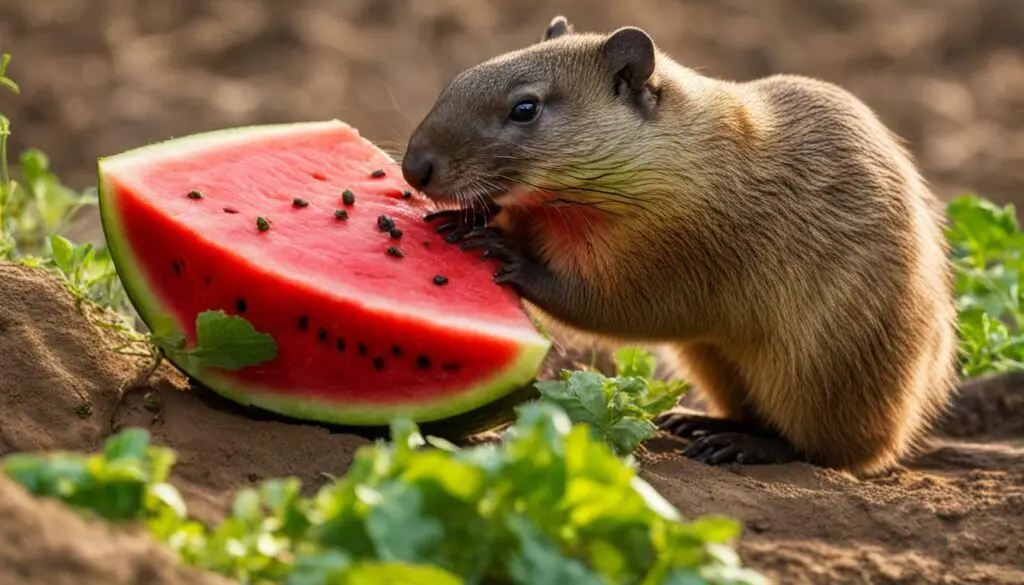
Let’s dive into whether groundhogs have the physical capability to consume watermelon and how much they typically consume. Groundhogs are herbivores, which means their diet mainly consists of plant matter. Watermelon, being a delicious fruit, is indeed on the menu for these critters. While they may not necessarily have a strong preference for watermelon, groundhogs do enjoy munching on its juicy, red flesh.
When it comes to watermelon, groundhogs tend to leave the rind and seeds behind, focusing primarily on the sweet, fleshy part. While their consumption of watermelon may be moderate compared to other fruits and vegetables, it is still an occasional part of their diet. Groundhogs, being opportunistic eaters, will consume watermelon if it is readily available and accessible.
To give you a better idea of groundhog consumption of watermelon, let’s take a look at an overview of their dietary habits. Groundhogs typically consume various types of vegetation such as grass, clover, dandelions, and other leafy greens. They also enjoy munching on fruits and vegetables such as berries, apples, carrots, and yes, watermelon.
| Food | Proportion in Groundhog Diet |
|---|---|
| Leafy greens | High |
| Fruits and vegetables | Moderate |
| Watermelon | Low |
While groundhogs may not devour watermelon in large quantities, it is important for backyard owners to take precautions to protect their precious crops. Fencing the garden area and using natural repellents can help keep groundhogs at bay and safeguard watermelon and other plants from their nibbling tendencies.
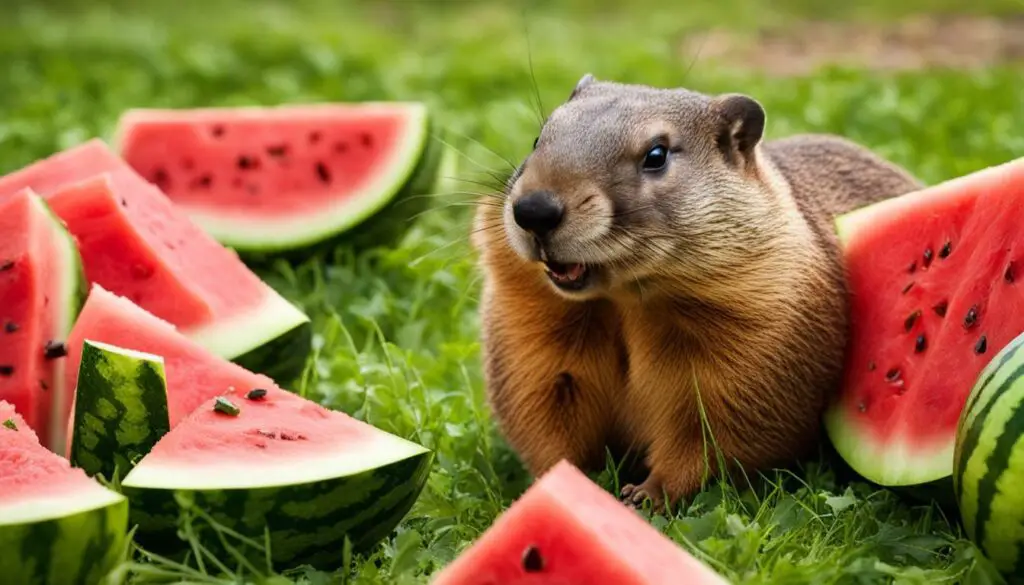
- Groundhogs can consume watermelon, although it is not their preferred food.
- They primarily eat the fleshy part of the watermelon, leaving the rind and seeds behind.
- Watermelon is a small part of their overall diet, which mainly consists of leafy greens, fruits, and vegetables.
- Backyard owners should take measures to protect their watermelon and other plants from groundhog interference, such as using fencing and natural repellents.
How Groundhogs Eat Watermelon
Understanding how groundhogs eat watermelon can provide insights into their behavior and preferences. While groundhogs are primarily herbivores, they do enjoy indulging in the juicy, red part of the watermelon. When it comes to watermelon consumption, groundhogs tend to leave the rind and seeds behind, focusing solely on the sweet and refreshing flesh of the fruit.
Feeding watermelon to groundhogs can be an interesting experience to observe. They have a unique way of devouring this treat. Groundhogs will often gnaw and chew on the watermelon, savoring each bite. You may even catch them tilting their heads back to better access the juice inside the fruit.
To paint a clearer picture of how groundhogs eat watermelon, here is a table summarizing their feeding habits:
| Eating Habits | Description |
|---|---|
| Preference | Groundhogs primarily consume the juicy, red part of the watermelon. |
| Exclusion | They tend to leave behind the watermelon rind and seeds. |
| Chewing | Groundhogs will gnaw and chew on the watermelon, relishing each bite. |
| Head Tilt | They may tilt their heads back to better access the juice inside the fruit. |
It’s important to note that while groundhogs do eat watermelon, it is just a small part of their overall diet. They also consume a variety of vegetables and fruits in addition to other plants. If you’re a backyard owner, it’s advisable to take protective measures to safeguard your watermelon and other plants from groundhog interference. You can consider fencing your garden or utilizing natural repellents to prevent these furry creatures from feasting on your harvest.
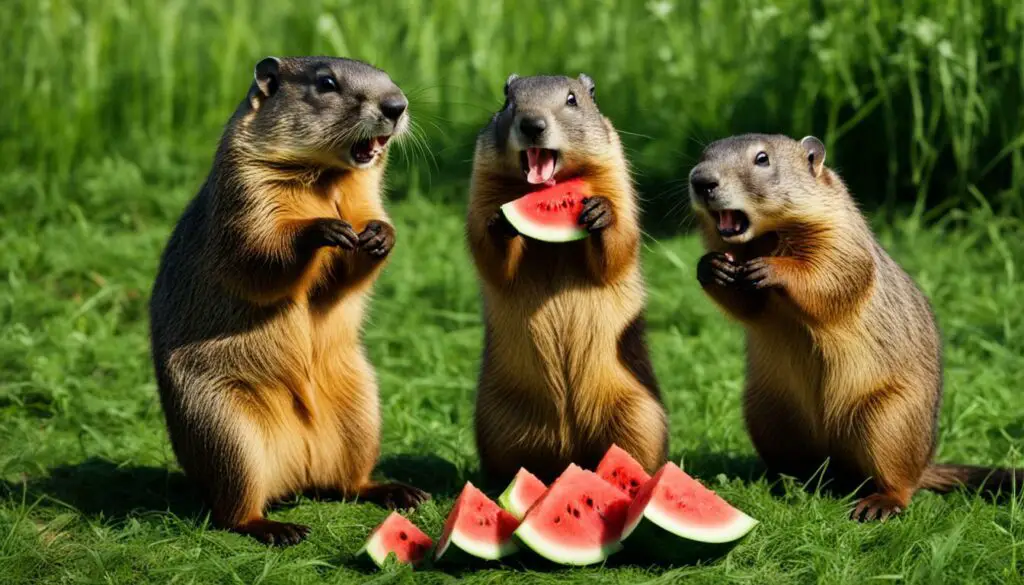
Groundhogs have specific eating habits when it comes to watermelon. These herbivorous creatures enjoy indulging in the juicy, red part of the watermelon while leaving the rind and seeds behind. Although watermelon may not be their preferred fruit, groundhogs do consume it in small quantities as part of their varied diet.
When presented with a fresh watermelon, groundhogs tend to focus their attention on the fleshy, sweet interior. Their sharp incisors allow them to easily tear through the soft fruit, savoring the succulent red flesh. While groundhogs may not devour the entire watermelon in one sitting, their occasional consumption adds a refreshing treat to their daily meals.
If you have a backyard garden and are concerned about groundhog interference with your watermelon plants, it’s essential to take preventive measures. One effective strategy is to install a sturdy fence around the garden area. This barrier can deter groundhogs from accessing your prized watermelons, reducing the risk of damage to the fruits and overall crop.
| Edible Parts of Watermelon for Groundhogs | Discarded Parts of Watermelon |
|---|---|
| The sweet, juicy red flesh | The tough green rind |
| The seeds |
By understanding groundhog eating habits and their preference for certain parts of the watermelon, you can also consider incorporating natural repellents to protect your watermelon crop. Planting herbs such as mint or placing a garlic spray can act as deterrents, deterring groundhogs from feasting on your harvest.
In conclusion, while watermelon is not a staple in a groundhog’s diet, it is indeed a source of enjoyment for these herbivores. As backyard owners, it’s important to be aware of their eating habits, and take necessary precautions to safeguard your watermelon and other plants from groundhog interference.
Related: Groundhogs and Their Herbivorous Diet
Protecting Watermelon from Groundhogs
As a backyard owner, it’s important to protect your watermelon crops from groundhog damage. Here are some effective ways to keep these critters at bay.
1. Install a sturdy fence: Surrounding your garden with a fence is one of the most effective ways to deter groundhogs from reaching your watermelon plants. Make sure the fence is buried at least one foot underground to prevent them from burrowing underneath. Opt for a fence with small mesh openings to prevent groundhogs from squeezing through.
2. Use natural repellents: Groundhogs have a strong sense of smell, so incorporating natural repellents can help deter them from your watermelon crops. Consider using repellents such as predator urine, garlic spray, or chili powder. Reapply them regularly, especially after rainfall.
3. Remove attractants: Keep your backyard free from tempting food sources that may attract groundhogs. Ensure that fallen fruits, vegetables, and compost piles are cleaned up regularly. By eliminating potential food sources, you can reduce the likelihood of groundhogs discovering your watermelon plants.
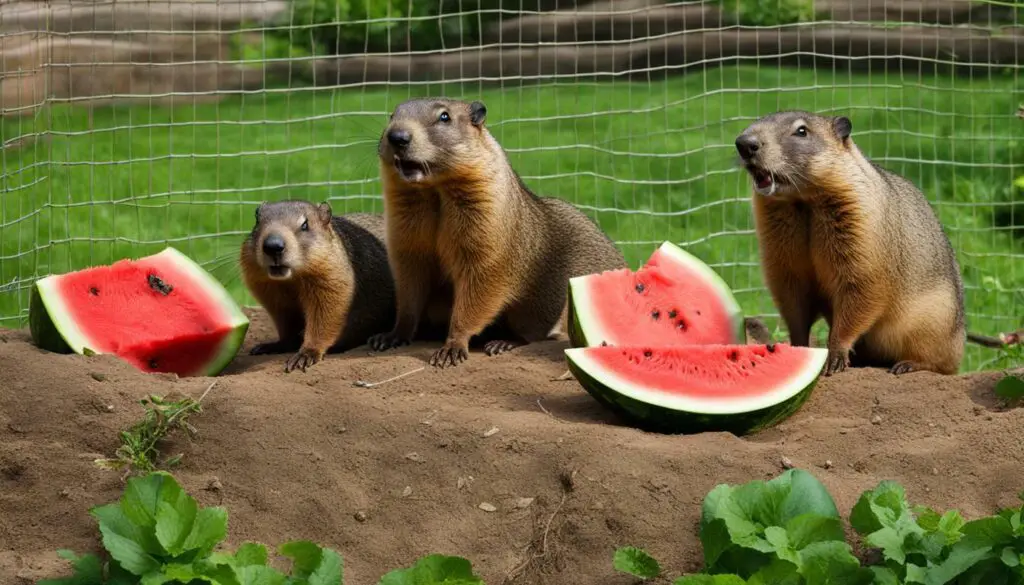
Remember, groundhogs are persistent creatures, so it’s crucial to employ multiple deterrents and remain vigilant throughout the growing season. By implementing these protective measures, you can enjoy a bountiful watermelon harvest while ensuring your crops remain safe from these hungry herbivores.
Groundhogs and Watermelon: A Small Part of Their Diet |
|---|
|
While groundhogs do eat watermelon, it is important to note that it constitutes only a small portion of their overall diet. These herbivorous mammals primarily consume a variety of vegetables and fruits, with watermelon being one of the many options they enjoy. Groundhogs are particularly fond of the juicy, red part of the watermelon, savoring its sweetness and refreshing taste. However, they tend to leave the rind and seeds behind, focusing on the more succulent flesh of the fruit. Backyard gardeners should keep in mind that while groundhogs may occasionally indulge in watermelon, their overall intake of this fruit is limited. It is important to take appropriate measures to protect watermelon plants and other crops from groundhog interference. A combination of fencing the garden area and using natural repellents can help deter groundhogs from accessing the watermelon and prevent damage to the plants. These precautions will ensure that the watermelon crop remains intact and can be enjoyed by humans rather than becoming a groundhog’s feast. |
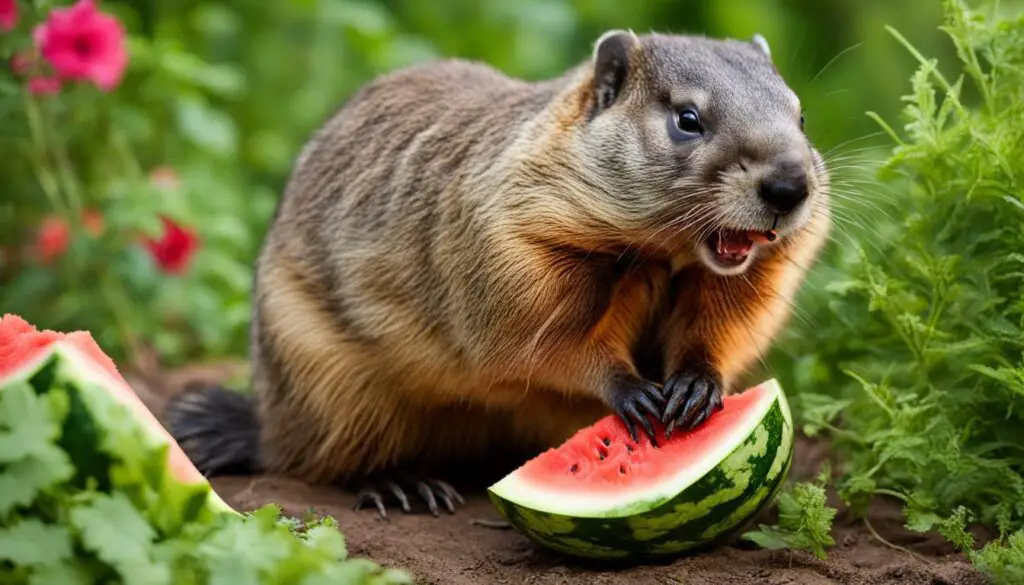
Groundhogs are herbivores by nature, relying on plant-based food sources to meet their nutritional needs. Their diet consists mainly of vegetation and is primarily composed of grasses, leaves, and various types of plants. Although they are known for their fondness for certain crops and garden plants, groundhogs have a diverse range of food preferences.
When it comes to fruits, groundhogs enjoy a variety of options, including watermelon. While watermelon may not be their favorite fruit, groundhogs do consume it in small quantities. They are particularly drawn to the juicy, red part of the watermelon, leaving the rind and seeds behind. Other fruits that groundhogs may consume include berries, apples, and peaches.
Additionally, groundhogs have a taste for vegetables such as carrots, lettuce, and cucumbers. They also graze on different types of grass, which makes up a significant portion of their diet. It is important to note that while groundhogs have a preference for certain foods, their diet can vary depending on the availability of food sources in their habitat.
| Vegetation | Fruits | Grasses |
|---|---|---|
| Grasses | Watermelon | Various types |
| Carrots | Berries | Wild grasses |
| Lettuce | Apples | |
| Cucumbers | Peaches |
Protecting Your Garden
For backyard owners, protecting watermelon and other crops from groundhog interference is crucial. Fencing the garden can be an effective measure to keep groundhogs out. Install a sturdy fence at least 3 feet deep into the ground to prevent them from burrowing underneath. Additionally, consider using natural repellents, such as predator urine or strong-smelling plants like garlic and onions, to deter groundhogs from entering the garden.
By implementing these preventive measures, you can help protect your watermelon and keep your garden safe from groundhog damage. Remember to regularly check and reinforce your garden defenses, as groundhogs are persistent animals when it comes to obtaining their desired food.
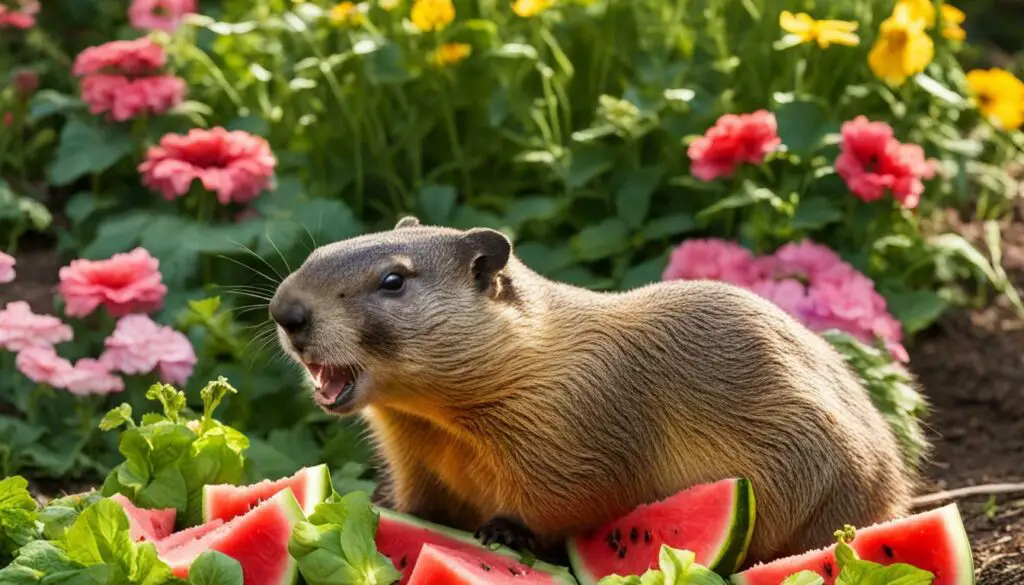
Groundhogs are fascinating creatures with unique dietary preferences. While they primarily rely on plant-based food sources, they do indulge in the occasional watermelon treat. Understanding their eating habits and taking proactive steps to protect your garden can help ensure a harmonious relationship with these herbivorous animals.
Conclusion
In conclusion, groundhogs are herbivores that do eat watermelon, although it is not a significant part of their diet. Groundhogs primarily consume the juicy, red part of the watermelon, leaving the rind and seeds behind. While they may not have a strong preference for watermelon, they do enjoy it in small quantities.
As backyard owners, it is important to take measures to protect your watermelon and other plants from groundhog interference. Fencing the garden can help prevent them from accessing the plants, while natural repellents can serve as a deterrent. By safeguarding your watermelon, you can ensure that it remains intact for your enjoyment.
While groundhogs may occasionally indulge in watermelon, it is just a small part of their broader food intake. They have a primarily herbivorous diet, consuming a variety of vegetables and fruits. Watermelon is just one of the many options available to them.
FAQ
Do groundhogs eat watermelon?
Yes, groundhogs do eat watermelon, along with other vegetables and fruits.
What parts of the watermelon do groundhogs eat?
Groundhogs primarily eat the juicy, red part of the watermelon, leaving the rind and seeds behind.
Is watermelon a favorite food for groundhogs?
While groundhogs may not be particularly fond of watermelon, they do consume it in small quantities.
How can I protect my watermelon from groundhogs?
To protect your watermelon and other plants from groundhogs, you can consider fencing your garden and using natural repellents.
Is watermelon a significant part of a groundhog’s diet?
Watermelon is just a small part of a groundhog’s overall diet.
What do groundhogs primarily eat?
Groundhogs are herbivores and primarily eat a variety of vegetables and fruits.

